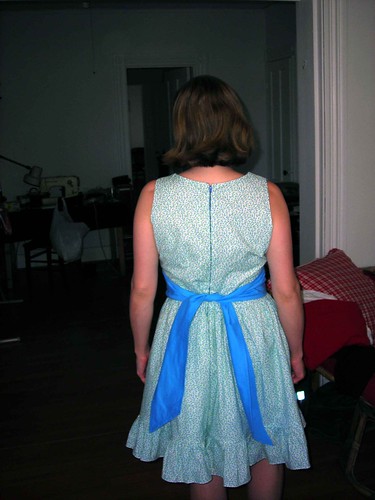

And this is the dress I just sewed in a fit of nostalgia for girly, frilly clothing. The ruffler attachment and I had a fine time.
On the one hand, every work place has a dress code. Bankers wear suits. Nurses wear scrubs (or slacks and a shirt). Business-casual workers wear khakis and a nice shirt, and so on. To some extent, these acceptable categories are narrowly defined, unless one is in California or some similarly enlightened place. (Or in a more, shall we say, accepting academic environment.)
On the other hand, I have never seen any of our female faculty wear other than: shirtdresses; slacks and a blouse; slacks or skirt and a sweater. And I saw one wear a suit once.
If I wore this dress to lab, it would destroy whatever credibility I have left in my coworkers' eyes. One mustn't be too frilly, after all. Why? Well, in my experience, some of it is because, as I've said before, feminine is equated with not-serious-about-work. A floral skirt means you were thinking about clothing rather than science that morning. And so on.
But some of it is legitimate. Stiletto heels are not appropriate for treating indigent patients at the free clinic. Flouncy dresses will, inevitably, knock over the pipettes' bleach bath.
I think part of this attitude springs from- I don't quite know how to express it- expecting women to pretend to be men. Heaven forbid you should wear anything with lace at the hem. It doesn't project tough and in charge, which, at least around here, is what one needs to succeed.
Where does pretty clothing become truly inappropriate for work? Other than the obvious: stilettos and feathered headdresses. So where's the line?